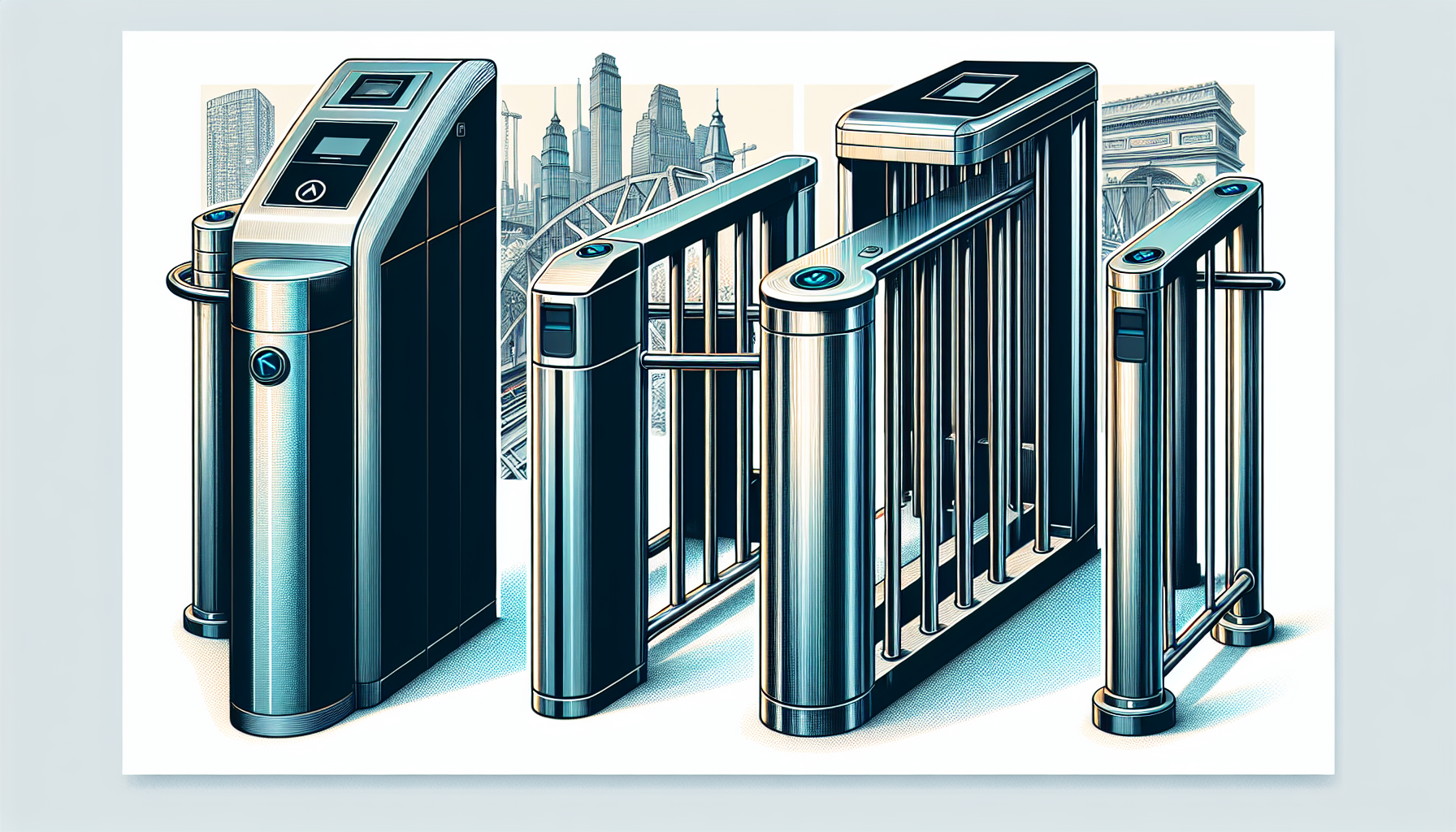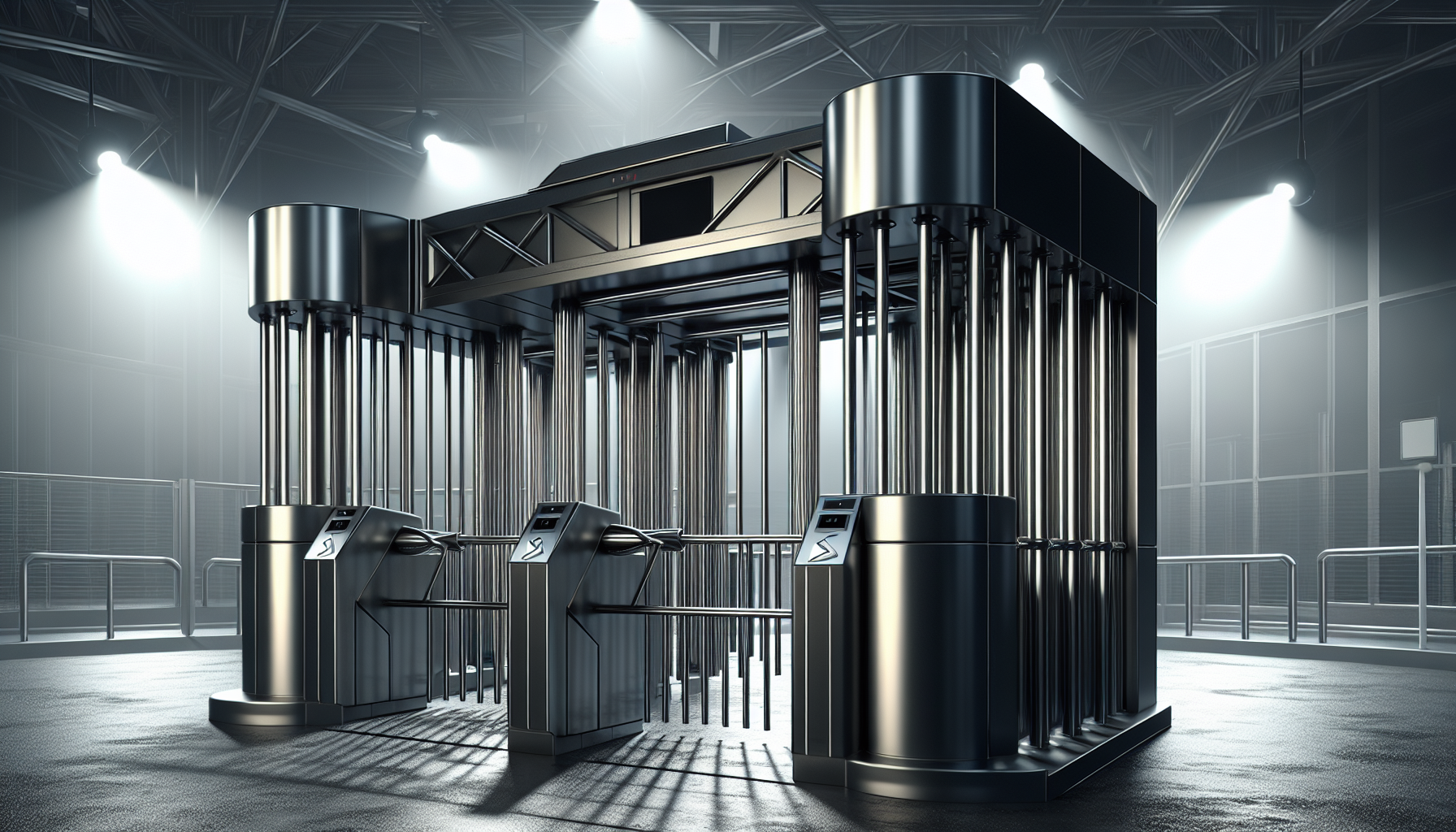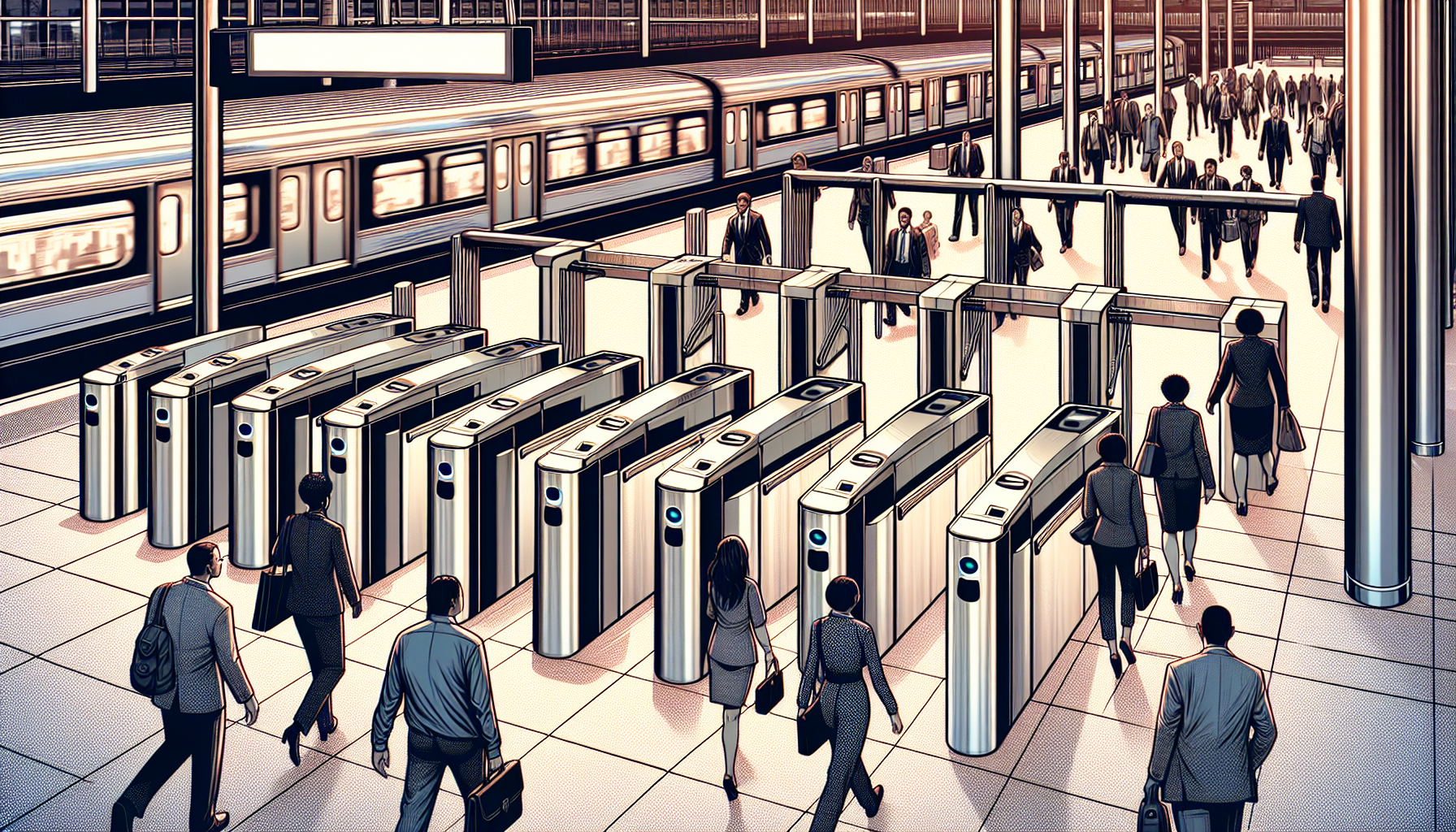How Turnstiles Improve Security And Access Control?
Turnstiles control and monitor entry and exit points, ensuring that only authorised individuals can pass through. They are commonly found in areas requiring security, such as public transportation stations, sports venues, and high-security buildings. This article will explore the different types of turnstiles, their benefits, and their applications, answering the question: What are turnstiles used for?
Key Takeaways
- Turnstiles significantly enhance security by creating controlled access points that integrate with various security systems, including surveillance cameras and biometric devices.
- Different types of turnstiles, such as tripod, full-height, waist-high, optical, and barrier arm turnstiles, cater to specific security needs and environments, from high-security areas to public transportation stations.
- Turnstiles improve operational efficiency by automating entry processes, reducing staffing needs, and providing valuable data on pedestrian flow and peak times, which aids in resource management and planning.
Definition of Turnstiles
Turnstiles are devices designed to control entry and exit to a building, room, or area, often requiring some form of authorisation or payment for access. These access control turnstiles are vital in managing site security and pedestrian flow, ensuring that only one person can pass through at a time. The fundamental purpose of turnstiles is to regulate who can enter and when providing a controlled environment for various settings.
Typically, turnstiles consist of a post with horizontal bars that rotate to allow entry. This turnstile mechanism controls the opening and closing of the blocking rod, ensuring that each person entering is validated. Modern turnstiles are equipped with advanced technology to enhance security, crowd control, and access management.
There are various types of turnstiles, each designed for specific applications and security levels. Some common types of turnstiles include:
- Tripod turnstiles: commonly found in public transport stations
- Full-height turnstiles: used in high-security areas
- Waist-high turnstiles: often used in stadiums and amusement parks
- Optical turnstiles: equipped with sensors to detect unauthorized entry
- Barrier arm turnstiles: commonly used in parking lots and toll booths
Understanding the different types of turnstiles helps select the right one for each unique requirement.
Enhancing Security with Turnstiles
In today’s world, where security threats are ever-present, implementing effective security measures is essential for protecting assets, employees, and customers. A security gate acts as a primary layer of protection, while turnstiles provide a secondary layer of security, complementing perimeter measures like gates and barriers. By restricting access to authorised personnel, turnstiles offer an additional level of protection that is both efficient and reliable.
One key advantage of security turnstiles is their ability to integrate with other security systems, such as surveillance cameras and alarm systems. This integration creates a comprehensive security network that deters unauthorised entry and monitors foot traffic. Turnstiles can also be configured with advanced detection features to alert security personnel of any suspicious activity, such as tailgating or loitering.
Moreover, turnstiles offer several benefits:
- They reduce the need for human intervention in access control, which is particularly beneficial for large or busy sites.
- By automating the entry process, turnstiles ensure that only those with proper credentials can gain access, thereby maintaining security and order.
- This not only enhances security but also improves workflow and efficiency for businesses.
Managing Entry Points
Managing entry points efficiently is crucial in high-traffic areas such as subway stations to prevent congestion and ensure smooth operations. Turnstiles excel in this regard by regulating the flow of foot traffic and preventing unauthorized access. Whether it’s a subway station or an amusement park, turnstiles streamline entry and exit processes, making them faster and more orderly.
Turnstiles can operate in one or both directions, allowing for greater control over pedestrian flow and entry management. This functionality is particularly useful in venues that require ticket validation or payment upon entry, such as sports venues and public transportation terminals. By automating the credential-checking process, turnstiles increase overall efficiency and throughput at access points.
Additionally, turnstiles can be equipped with counters to accurately measure foot traffic flow and peak times. This data is invaluable for managing resources and planning for busy periods. By providing a clear and controlled entry process, turnstiles ensure that every person entering is accounted for, enhancing both security and operational efficiency.
Types of Turnstiles

Turnstiles come in various types, each designed to meet specific security needs and applications. One of the most common types is the tripod turnstile, which features three rotating arms. Due to their durability and ease of use, tripod turnstiles are often used in public transportation stations, stadiums, and amusement parks. They are ideal for efficiently managing large numbers of people.
Full-height turnstiles, on the other hand, extend from the floor to the ceiling and provide robust security. They are commonly used in high-risk areas such as data centres and prisons, where unauthorised access must be strictly prevented. Made of sturdy metal, full-height turnstiles are tall enough to avoid climbing over, making them a formidable barrier.
Optical turnstiles represent a more modern approach to access control. Using infrared or laser beams, these turnstiles can detect the passage of individuals without the need for physical barriers. This makes them suitable for corporate lobbies and other environments where aesthetics are essential. Waist-high turnstiles, which restrict entry at waist level, are commonly found in public transportation systems and sports stadiums.
Each type of turnstile offers unique advantages, and selecting the right one depends on the specific security requirements and environment. From high-security full-height turnstiles to sleek optical turnstiles, understanding the different types helps make an informed decision for any application.
Integration with Access Control Systems
Integrating turnstiles with access control systems significantly enhances security and operational efficiency. These systems can include card readers, biometric devices, and QR code scanners, ensuring that only authorised personnel can gain access. By capturing data on the specific time, identity, and location of each person entering or leaving, turnstiles provide a detailed log that is invaluable for security purposes.
Turnstiles with advanced microprocessors can track entrants and manage communications between hardware and software, further enhancing overall system efficiency. This integration allows for seamless communication between the turnstile and other security systems, such as video surveillance cameras. Capturing images of users and analysing this data provides a holistic view of security, enabling quick responses to potential threats.
The ability to integrate turnstiles with various access control systems offers several benefits:
- Increased security: By allowing multiple authentication methods, such as access cards, biometric scanning, or PIN codes, turnstiles ensure that only specific cleared individuals can access secure areas.
- Improved user experience: Integrating turnstiles with access control systems provides authorised individuals with a seamless and efficient entry process.
- Flexibility: Integrated turnstile systems offer the flexibility to adapt to different security requirements and access control strategies.
These advantages make integrated turnstile systems, which serve as a vital component of an access control system, crucial for modern access control strategies.
Data Collection and Analysis
Turnstiles are not just about controlling access; they also provide valuable information for strategic planning and resource allocation. By collecting data on entry and exit, turnstiles reveal traffic patterns, peak times, and daily usage. This data is particularly useful in environments like amusement parks and public transportation systems, where understanding foot traffic flow is crucial.
Analysing turnstile data helps identify anomalies in traffic patterns, which may indicate special events or disruptions. Aggregating this data allows for a comprehensive view of overall traffic by station and date, aiding in efficient resource management and planning. By leveraging the insights provided by turnstile data, organisations can optimise their operations and enhance the user experience.
Cost Efficiency
Installing turnstiles offers significant cost-saving benefits by streamlining access control operations and reducing staffing requirements. The benefits of installing turnstiles include:
- Streamlining access control operations
- Reducing staffing requirements
- Allowing users to present their credentials to gain entry, lessening the burden on receptionists and security guards
- Enabling facilities to operate more efficiently, with less staff needed at entrances
Access control and site security can be efficiently and cost-effectively managed with turnstiles. These systems are highly effective in controlling the flow of people and enhancing security measures at various locations. By preventing unauthorised entry, turnstiles restrict access and minimise losses from unpaid entry, which can be a significant issue in venues like sports stadiums and amusement parks. The overall efficiency improvements in access control operations contribute to better security and reduced operational costs.
Visual Deterrence

Turnstiles, particularly full-height ones, are a strong visual deterrent to unauthorised access. Their robust construction and sheer size make it clear that gaining unauthorised entry would be challenging, deterring potential intruders before they even attempt to breach the security. This visual deterrence is a powerful tool in maintaining security and preventing incidents.
Full-height turnstiles offer several advantages over half-height turnstiles:
- They present a stronger visual deterrent
- They reduce the risk of tailgating
- They ensure that only authorised individuals can gain access
- They enhance the overall security of the premises, making it more difficult for unauthorised persons to enter.
Emergency Situations
In emergencies, turnstiles play a crucial role in ensuring efficient and safe evacuations while maintaining security barriers. Some features that make turnstiles effective in emergencies include:
- Breakaway arms: These provide clear paths for evacuation, allowing for quick and orderly exits.
- Emergency exit buttons: These can be pressed to open the turnstile gates in case of an emergency, ensuring a swift evacuation.
- Lockdown support: Turnstiles can be configured to support lockdowns during security breaches, preventing unauthorised entry and aiding in the evacuation process.
These features make turnstiles an important tool in emergencies, helping to maintain safety and security.
Turnstiles with anti-panic features use infrared sensor modules to prevent mishaps during emergencies, ensuring the safety of individuals. Additionally, turnstiles can operate in fail-safe or fail-secure modes, unlocking or remaining locked during power failures to either allow free passage or maintain security. These features make turnstiles an essential component of any emergency response plan, providing both security and safety.
Applications of Turnstiles

Turnstiles are used in a wide range of settings to:
- Manage pedestrian flow
- Regulate access
- Control access and manage ticketing in urban rail transit systems
- Control entry and enhance security and efficiency in sports venues.
Turnstiles are versatile and can be used in various applications, including:
- Warehouses
- Public transportation terminals
- Construction sites
- Government buildings
Turnstiles provide controlled entrances and enforce payment upon entry, making them critical for maintaining order and security. They can be used in both indoor and outdoor settings.
Choosing the Right Turnstile
Selecting the right turnstile involves considering several factors, including:
- The level of security required
- Indoor or outdoor use
- Aesthetics
- Specific features
For high-security areas like bank vaults and defence facilities, full-height turnstiles are the best choice due to their robust construction and ability to prevent unauthorized access. In contrast, waist-high turnstiles or speed gates are suitable for areas requiring less stringent security.
The features to consider when choosing a turnstile include:
- Crossing capacity or flow rate: A good turnstile should allow approximately 25 persons per minute.
- Passage width: A width of 560 mm is recommended for effective crowd control.
- Aesthetic features: Turnstiles with visually appealing designs, such as sweeper speed blades, are ideal for corporate lobbies and other high-profile environments.
When choosing a turnstile, it is essential to consider the quality and specific features offered by different manufacturers. Here are some factors to consider:
- Turnstiles from ISO-certified companies ensure safety and prevent physical harm to pedestrians.
- Confirm where the turnstiles are built.
- Check the support resources available from the factory or authorized dealer network before making a decision.
Summary
Turnstiles are an indispensable part of modern access control and security strategies. They enhance security by restricting access to authorised personnel, streamlining foot traffic, and providing valuable data for strategic planning. From tripod turnstiles in public transport stations to full-height turnstiles in high-security areas, these devices play a crucial role in maintaining order and safety.
As technology advances, the integration of turnstiles with access control systems and other security measures will continue to improve. The future of turnstile technology promises even greater efficiency and security, making them an essential component of any comprehensive security plan. Embracing these advancements will ensure that facilities remain safe, secure, and efficient.
Frequently Asked Questions
What are turnstiles?
Turnstiles are devices used to control access to a building or area, often requiring authorisation or payment for entry.
How do turnstiles enhance security?
Turnstiles enhance security by restricting access to authorised personnel, integrating with other security systems, and providing advanced detection and lockdown capabilities.
What types of turnstiles are available?
Various types of turnstiles are available, such as tripod turnstiles, full-height turnstiles, waist-high turnstiles, and optical turnstiles, each catering to specific security needs. Choose the one that best fits your requirements.
How do turnstiles manage entry points?
Turnstiles manage entry points by streamlining foot traffic, preventing congestion, enforcing payment, and providing data on foot traffic flow and peak times for efficient and secure access management.
What factors should be considered when choosing a turnstile?
When choosing a turnstile, consider the level of security, indoor or outdoor use, aesthetics, specific features, crossing capacity, and the quality and support offered by the manufacturer. These factors play a crucial role in making an informed decision.




